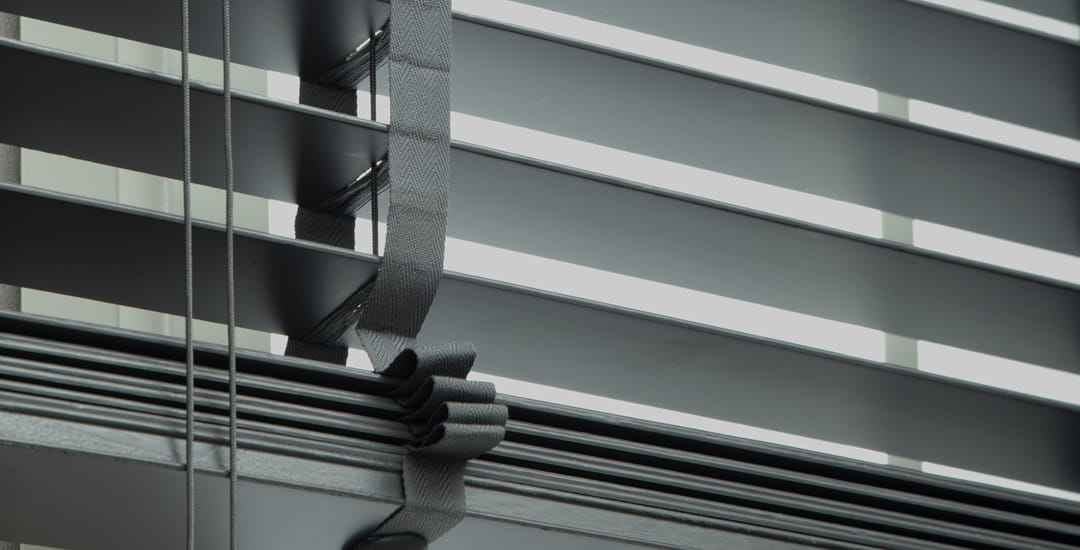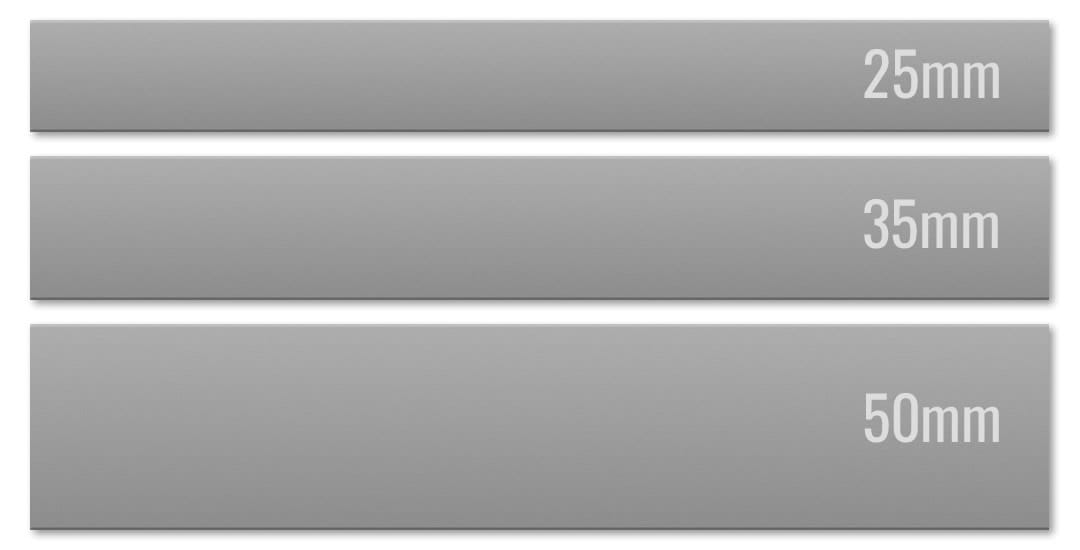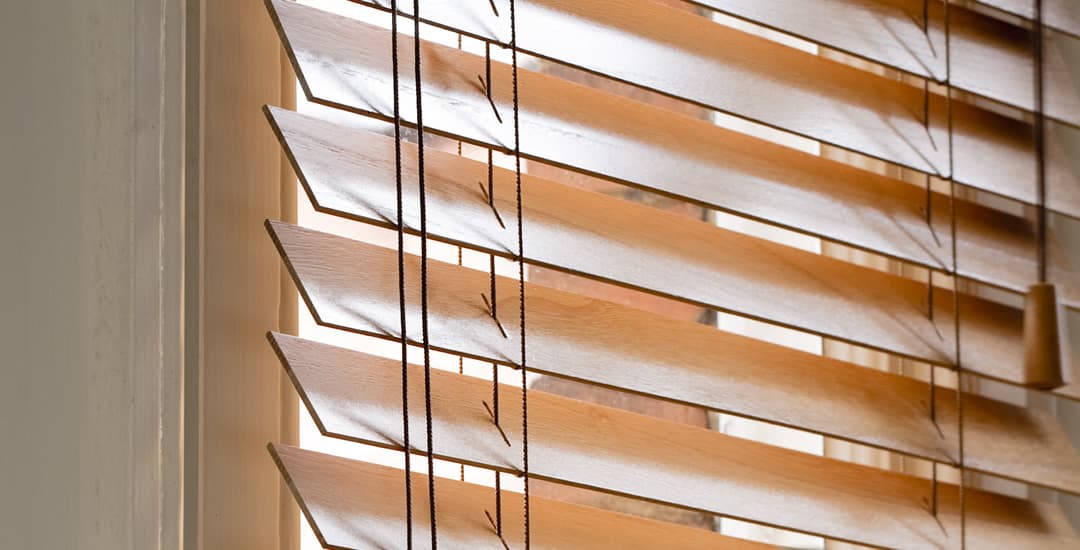
When people ask “how wide are the slats on wooden blinds,” they tend to mean this in terms of the depth that each slat measures from front to back, rather than how wide side to side horizontally the slat and so, blind is – this latter literally being a “how long is a piece of string/how wide is a blind” kind of question!
So, how wide are wooden blind slats? There are three standard or very common sizes in terms of the depth of wooden blind slats available from most retailers, which are 25mm, 35mm, and 50mm respectively.
Exactly what’s on offer within any blinds retailer’s range will depend on the manufacturer or retailer in question, but the usual options for the depth (or width, depending on your preferred terminology) of wooden blind slats are 25mm, 35mm, and 50mm.
When you’re making your purchasing decision, the width of the slats for any given blind will almost certainly either be clearly indicated in the blind’s description, or potentially (for made-to-measure blinds retailers) you will be given a range of options to choose from, allowing you to customise your blind to match your own requirements.
This often takes people aback, because not everyone can immediately parse why wooden blind slat widths might come in various different options in the first place, and so, they draw a blank as to what size might be best for them or what to consider when deciding.
With this in mind, this blog post will talk about how wide wooden blind slats can be, and why you might want to choose a certain size over a different option for your own blinds.
How wide are wooden blind slats on made-to-measure blinds?
Made-to-measure wooden blinds where you choose your own exact drop and length will often have options for the width or depth of the slats too, which will almost always be 25mm, 35mm, or 50mm.
The slat width for any given option will usually be indicated on the thumbnail and introductory description snippet for each wooden blind within a range, and you will often find the same colour/style and design of blind offered in all three options.

What size wooden blind slats are best?
If you have to pick between 25mm, 35mm, and 50mm wide (or deep) wooden blind slats, first up, there is no “best” or overall winner.
There are some points that go in favour of one size rather than another for certain reasons/applications/blind or window sizes or features, but even if you pick your winner from a hat and find out later that a different option might have been preferable, this will usually constitute a minor niggle rather than an aesthetic or functional failing.
How wide are wooden blind slats of the most popular type?
50mm slats are the most popular option; we sell a lot more wooden blinds with 50mm slats than we do either of their narrower cousins. This is because like for like, fewer slats are needed to construct the blind if the slats are larger – approximately half as many as if you chose 25mm slats, and um, somewhere a shade fewer than half as many if you chose 35mm slats (see table below).
The benefits of this for you, the buyer? Fewer slats to clean, and a clearer view of outside when your blind is lowered but your slats are tilted horizontally in order to increase your privacy.
Also, when the blind is fully raised, the fewer the slats in the stack (even if each slat is wider) the less it occludes the glass, once more, helping you to retain an unobstructed view of outside.
The table below shows the number of slats a wooden blind with a height (drop) of one metre will have, for each of the three slats width options:
| Slat Width | No. of slats |
| 25mm | 42 |
| 35mm | 32 |
| 50mm | 22 |
Why aren’t all wooden blinds made with 50mm slats then?

If 50mm slats have a couple of advantages over narrower ones in functional terms, why not just pick these for every window then? Come to think of it, why not just make all wooden blinds with 50mm slats and have done with it?
Aesthetics. Generally, we (and most folk) would agree that smaller, narrower slats like the 25mm’s look best in small windows, medium slats in the 35mm realm look best in medium-sized windows, and 50mm slats look best in larger windows.
This is just down to your preferred visuals, and there’s no hard and fast rule; and particularly when it comes to medium-sized windows, any of the three size options will look and function perfectly fine and not look at all out of place in most people’s opinions.
For larger windows, small, narrow 25mm slats don’t look intrinsically wonky either. But they can add to the weight of an already-large blind and make it hard to operate, as well as potentially interfering with the view from a window that may have been selected as a biggun’ specifically due to the view from it.
Coupled with this, a tall window with thin slats will fold up into a hugenormous stack at the top of the glass that can look significantly LOL even on a very big window.
I think the slat width/window size pairing that most gives me the twitch though, is the choice of 50mm slats in really small windows, like tiny downstairs toilet windows often are, being potentially only 30cm or so wide and 45cm high.
50mm slats (5cm, if that helps you to visualise it better) on a window like this would tend to swamp the window, messing with the perspective of it like those comedy-oversized sofas you often get at theme parks for family photo ops. I mean yes, they’re amusing; but think it through, “it looks funny” doesn’t tend to be high on most people’s lists of design must-haves when it comes to their interior décor.
Also, I can think of few things likely to give you a complex sooner than hearing literally every visitor that uses your downstairs toilet start to laugh for reasons unwarranted by anything you’ve deliberately put in there…




